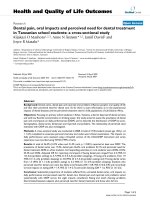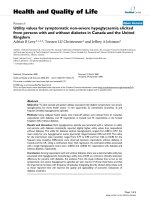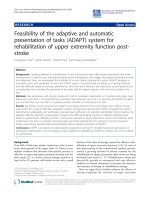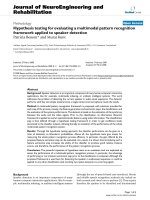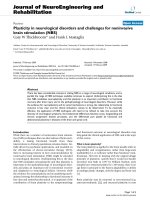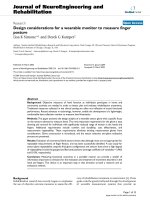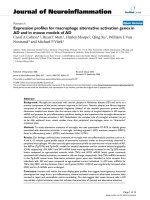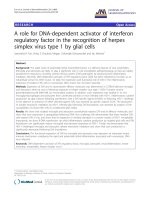báo cáo hóa học:" Endoscopic decompression for intraforaminal and extraforaminal nerve root compression" docx
Bạn đang xem bản rút gọn của tài liệu. Xem và tải ngay bản đầy đủ của tài liệu tại đây (538.06 KB, 7 trang )
RESEARCH ARTICLE Open Access
Endoscopic decompression for intraforaminal and
extraforaminal nerve root compression
Toshio Doi
*
, Katsumi Harimaya, Yoshihiro Matsumoto, Osamu Tono, Kiyoshi Tarukado and Yukihide Iwamoto
Abstract
Objective: The purpose of this study was to evaluate the outcome of endoscopic decompression surgery for
intraforaminal and extraforaminal nerve root compression in the lumbar spine.
Methods: The records from seventeen consecutive patients treated with endoscopic posterior decompression
without fusion for intaforaminal and extraforaminal nerve root compression in the lumbar spine (7 males and 10
females, mean age: 67.9 ± 10.7 years) were retrospectively reviewed. The surgical procedures consisted of lateral or
translaminal decompression with or without discectomy. The following items were investigated: 1) the
preoperative clinical findings; 2) the radiologic find ings including MRI and computed tomography-discography; and
3) the surgical outcome as evaluated using the Japanese Orthopaedic Association scale for lower back pain (JOA
score).
Results: All patients had neurological findings compatible with a radiculopath y, such as muscle weakness and
sensory disturbance. MRI demonstrated the obliteration of the normal increased signal intensity fat in the
intervertebral foramen. Ten patients out of 14 who underwent computed tomography-discography exhibited disc
protrusion or herniation. Selective nerve root block was effective in all patients. During surgery, 12 patients were
found to have a protruded disc or herniation that compressed the nerve root. Sixteen patients reported pain relief
immediately after surgery.
Conclusions: Intraforaminal and extraforaminal nerve root compression is a rare but distinct pathological condition
causing severe radiculopathy. Endoscopic decompression surgery is considered to be an appropriate and less
invasive surgical option.
Background
Intraforaminal and extraforaminal n erve root compres-
sion at lumbar lesions is much rarer than intraspinal
canal lesions, making the diagnosis difficult [1]. The dif-
ficulties in making a co rrect diagnosis could unfortu-
nately result in a failed lumbar spine surgery.
Surgical intervention is considered for patients with
severe radiculopathy that does not respond to conserva-
tive treatment. As interv erebral foraminal nerve entrap-
ment mostly affects the elderly, it is better to choose a
minimally-invasive surgical procedure. Consequently, we
have treated patients with intraforaminal and extrafor-
aminal ne rve root compression by posterior decompres-
sion surgery without fusion. This procedure can obtain
clear visualization of the deep surgical field with mini-
mal damage to the posterior lumbar structure [2-5].
The purpose of this study was to elucidate the radiolo-
gical findings, including those obtained by computed
tomography-discography, and the surgical outcomes and
limitations of posterior decompression without fusion
for this relatively uncommon disease.
Methods
Seventeen patients (7 males and 10 females, mean age at
the time of surgery: 67.9 ± 10.7 years, range: 40 - 88
years) with intervertebral foraminal entrapment were
treated by endoscopic posterior decompression at
Kyushu University Hospital from 2008 to 2010. The
mean follow-up period was 10.8 moths (ra nge: 4 - 20
months). All patients had leg pain that did not respond
to conservative treatment, such as NSAIDs, epidural
steroid injection or the use of a brace. Three patients
* Correspondence:
Department of Orthopaedic Surgery, Graduate School of Medical Sciences,
Kyushu University, Fukuoka, Japan
Doi et al . Journal of Orthopaedic Surgery and Research 2011, 6:16
/>© 2011 Doi et al; licensee BioMed Central Ltd. This is an Open Access article distributed under the terms of the Creative Commons
Attribution License ( 2.0), which permits unrestricte d use, distribution, and reproduction in
any medium, provided the original work is properly cited.
had a history of previous lumbar surgery, including pos-
terior decompression of the spinal canal. They had
experienced only slight improvement after the previous
surgeries.
A diagnosis of intraforaminal or lateral entrapment was
established in each patient based on the results of both
neurological and radiological examinations . MR imaging
were performed in all patients. We performed CT disco-
grams for all but 3 patients to describe the positional rela-
tionship of the protruded disc to the posterior elements,
such as the facet, transverse process and pars interarticu-
laris, and such information was very useful for selecting
the optimal surgical approach. Selective nerve root blocks,
using 0.8 ml of 1% lidocaine, were also performed.
Surgical procedures
Posterior decompression was performed using a micro-
endoscope in all patients. Fourteen patients underwent
the extraforaminal approach [3] and 2 patients under-
went the translaminar approach [6,7]. In addition to
decompression of extraforaminal lesions, one patient
also underwent intraspinal canal decompression because
it was though likely that the intraspinal canal lesions
could not be excluded prior to the index surgery. The
METRx MED system (Medtronic Sofamor Danek) was
used for the entire procedure. The patient was placed
prone on a Hall frame. A skin incision of 2 cm was
made about 2 to 5 cm lateral to the spinous process.
After a muscle splitting approach using a series of
sequential dilators, a tubular retractor with a diameter
of 1.6 cm was set. For the translaminar approach, a
small oval fenestration about 8 mm in the hemi lamina,
cra niomedial ly to the fac et joint, was performed (Figure
1E). For the extraforaminal approach, the muscles
attached to the inferior transverse process an d the lat-
eral edge of the facet were removed, and the vertebral
disc was isolated from the superior-medial portion of
the inferior transverse process. In case of the extrafor-
aminal herniation, the herniated disc may have pro-
truded in this lesion (Figure 2B). The nerve root was
also identified in this lesion or that just cranial to the
disc. I n case of a protruded disc, the disc just caudal to
the nerve root was removed using curetts and a punch.
No attempts were made to remove the osteophytes of
the vertebral body. The patients were then encouraged
to stand up and walk on the day after surgery.
Preoperative and Postoperative Evaluations
The following items were investigated: 1) the preopera-
tive radiological findings, including MRI and disco-CT
scans; 2) intraoperative disc protrusion; and 3) the surgi-
cal outcomes evaluated using the J OA score for lower
back pain (Table. 1).
Results
Clinical Findings
The neurological findings during the physical exam var-
ied in each p atient (Table 2). The Kemp sign was posi-
tive in 13 ( 76%) patients. The nerve root stretching test
(FNST or S LRT) was positive in 11 (65%) patients. In
cases with L3 or L4 nerve root involvement, the femoral
nerve stretching test was frequently positive.
Radiological Findings
MR imaging was pe rformed in all 17 cases. On MR
images, central spinal canal stenosis was not evident in
any patient. Parasagittal MRI at the foramen was use-
ful in assessing the presence of foraminal stenosis by
the obliteration of the normal increased signal inten-
sity fat (Figure 1A). CT-discography was performed
(Figure 1B, C) in 14 patients. Ten patients showed disc
protrusion in the foraminal (2 cases) or extraforaminal
(8 cases) lesion. A nerve root block with a local
anesthesic immediately relieved the radicular pain in
all 17 patients.
Intraoperative disc protrusion
During the intraoperative observations, 13 pat ients were
noted to have a prot ruding disc just caudal or anterior
to the nerve root. Among th ese, 2 cases had a herniated
disc just anterior to the nerve root, and the nerve root
seemed wide and flat just anterior t o the lateral facet,
such that the herniated disc could only be found after
exploration of t he anterior lesion of the nerve root. In
the cases with intraforaminal herniated disc removed by
the translaminar approach, a herniated disc was found
just caudal to the existing ner ve roo t. Four cases had no
disc protrusion, and only lateral fenestration, including
the resection of some ligamentum flavum without dis-
cectomy, was performed.
The intraoperative findings with or w ithout disc pro-
trusion were compatible to the CT-discogram findings
in all 14 cases who had undergone this examination.
Surgical outcomes
Sixteen patients reported relief of their preoperative
symptoms just after the sur gery. One patient reported
no pain relief. Three patients had later recurrence of the
same symptoms on the ipsilateral side, and 2 patients
had later appearance of symptoms on the contralateral
side of the surgery. The mean JOA scores were 10.8
before surgery and 20.2 at the final follow-up, and the
mean recovery rate was 54%.
No serious complications occurred in any of the
patients during the surgical procedure. Two patients
who had symptoms of remaining leg pain had revision
surgery by PLIF.
Doi et al . Journal of Orthopaedic Surgery and Research 2011, 6:16
/>Page 2 of 7
Figure 1 Case 6. Images from a 56-year-old male who presented with severe right leg pain. A: Para-sagittal MRI imaging (T1) showed the
obliteration of the normal increased signal intensity fat (arrow). B,C: Para-sagittal and axial reconstruction CT-discograms showed an
intraforaminal herniated disc (arrow) at the L5-S1 level. D: A CT-discogram obtained at L5-S1 showing partial resection in the L4 lamina (arrow).
E: Postoperative 3-D reconstruction showing the oval fenestration in the L4 lamina.
Figure 2 Case 13. A thr ee-dim ensional CT-discogram obtained from a 78-year-old male who presented with severe left leg pain.(A)
The herniated disc (*) was located from the intraforaminal to the extraforaminal lesion. (B) A tubular retractor was set at the dotted area, and
the herniated disc (*) was removed.
Doi et al . Journal of Orthopaedic Surgery and Research 2011, 6:16
/>Page 3 of 7
Discussion
The diagnosis of intraforaminal and extraforaminal
nerve root compressi on is difficult to establish based on
a single diagnostic modality. Comprehensive clinical and
radiological information are required. Patients with this
disease present with unilateral leg pain and demonstrate
deficits of exiting nerve root func tion, including muscle
weakness of the lower extremities. The Kemp sign,
which induces a narrowing of the foraminal and
extraforaminal area by forcing dorsolateral extension of
the lower back, was positive in most patients.
Radiologically, parasagittal MRI at the foramen was
useful for assessing the presence of foraminal stenosis
by the obliteration of t he normal increased signal inten-
sity fat. In our series, all 17 patients had features of for-
aminal stenosis on MRI, however, it was difficult to
deter mine whether the location of stenosis was intrafro-
mainal or extraforaminal in many cases. The causes of
stenosis in lateral lesions were a combination of pro-
truded discs, degenerated ligamentum flavum, protruded
osteophytes of the vertebral body, and degenerative
facets. It was difficult to determine which element(s)
had caused the nerve entrapment based on the findings
of MRI alone.
CT discography was therefore useful for elucidating
the participation of the protruded disc for the nerve
root entrapment at the lateral area. All cases that were
speculated to have a protruded disc by CT discography
also demonstrated corresponding surgical findings. The
3-D reconstruction of CT discograms could describe the
protrusion of the vertebral disc, especially compared to
the plane CT (Figure 3A, B). Three-dimensional recon-
struction of CT discograms can also describe the posi-
tional relationship of the protruded disc to the facet,
transverse process and pars (Fig ure 2A, B). These fea-
tureswereveryusefulfortheplanningofthesurgical
approach, especially since the endoscopic surgery can
only expose a small posterior element of the lumbar
spine.
There are several posterior decompression approaches
for performing intraforaminal and extraforaminal nerve
root compression at the lumbar spine. These include
the interlamina approach [8], translamina approach [6,7]
and extraforaminal approach [3,9-11]. For th e interla-
mina approach, the performance of a medial facetect-
omy with laminotomy may provide an adequate
exposure of medial foraminal lesions. However, this pro-
cedure is usually limited to the L5-S1 level because the
lamina at other levels is not wide enough to perform a
resection. For the translaminar approach, a small oval
fenestration in the hemilamina, craniomedially to the
facet joint, was performed. The translaminar approach is
usually applied at either the L3-L4 or the L4-L5 level,
because the lamina at L1 or L2 may be too thin to
make an oval hole to preserve the pars interarticularis
and the disc level at the L5-S1 level is usually too caudal
for this a pproach. For the extraforaminal approach, the
removal of the intertransversarious ligament may ade-
quately expose the lateral compartment. At the L5-S1
level, since the space between the sacral ala and L5
transverse process is usually very narrow, the lateral
edge of the L5-S1 facet joint and the superior-medial
portion of the sacral ala were resected.
Table 1 Criteria for the JOA scoring system
Subjective symptoms (9 points)
low-back pain
none 3
occasionally mild 2
always present of sometimes sever 1
always sever 0
leg pain &/or numbness
none 3
occasionally mild 2
always present or sometimes sever 1
always sever 0
walking ability
normal walking 3
able to walk > 500 m, pain/numbness/weakness present 2
unable to walk 500 m due to pain/numbness/weakness 1
unable to walk 100 m due to pain/numbness/weakness 0
objective finding (6 points)
straight leg raising
normal 2
30-70 degree 1
< 30 degree 0
sensory function
normal 2
mild sensory disturbance 1
apparent sensory disturbance 0
motor function
normal (MMT normal) 2
slight decrease muscle strength (MMT good) 1
marked weakness (Grade 3-0) 0
restriction of ADLs (14 points) †
none 2
moderate 1
severe 0
bladder function (-6 points)
normal 0
mild dysuria -3
severe dysuria -6
total score 29
*ADL = activities of daily living; MMT = manual muscle testing.
†ADL include the following; turning over while lying down, standing, washing
one’s face, leaning forward, ability to sit for approximately 1 hour, ability to
lift or hold heavy objects, and ambulatory ability.
Doi et al . Journal of Orthopaedic Surgery and Research 2011, 6:16
/>Page 4 of 7
Table 2 Patient characteristics and outcomes
Age,
Sex
Level Kemp
Sign
SLRT FNST Sensory
Disturb
Muscle
Weakness
disc protrusion CT
discogram
Preop conservative
treatment
disc protrusion
op-finding
Preop JOA
score
Postop JOA
score
Recovery
Rate (%)
different
outcomes
1 88, F L5-S1 + - - L5 - + 3 M + 3 11 30.8 Contralateral
side*
2 69, F L3-L4 + + + L4 IP, QF, EHL + 5 M + 7 14 31.8 Contralateral
side
3 70, F L5-S1 + - - L5 - - 2 M - 12 12 0 no pain relief
4 80, F L5-S1 + - - L5 EHL - 2 M - 12 19 41.2 Ipsilateral
side†
5 70, F L5-S1 + + - L5 EHL + 5 M + 11 20 50
6 56, M L4-L5 + + + L4 - + 14 M + 15 29 100
7 76, F L3-L4 - - + - - + 6 M + 14 28 93.3 Ipsilateral side
8 75, F L5-S1 + - - L5 EHL + 8 M + 5 20 62.5
9 67, M L5-S1 + + - L5 EHL + 9 M + 8 29 100
10 60, M L5-S1 + + - L5 EHL NA 4 M + 11 27 88.9
11 68, M L5-S1 - - - L5 - + 5 M + 11 21 55.6
12 40, F L5-S1 - + - L5, S1 - + 2 M + 14 19 33.3
13 78, M L5-S1 + - - L5 EHL + 6 M + 11 16 27.8
14 66, M L5-S1 - + - L5 EHL - 4 M - 20 28 88.9 Ipsilateral side
15 63, F L3-L4 + + - L3 - NA 7 M + 13 20 43.8
16 66, M L3-L4 + - + L3 IP, QF + 4 M + 13 20 43.8
17 62, F L4-L5 + - + - EHL NA 18 M + 4 11 28
10.8 ± 4.3 20.2 ± 6.2 54.1 ± 30.0
* contralateral side = later recurrence of the same symptom on the contralateral side of the surgery.
† ipsilateral side = later appearance of symptoms on the contralateral side of the surgery.
Doi et al . Journal of Orthopaedic Surgery and Research 2011, 6:16
/>Page 5 of 7
Surgical options for intraforaminal and extraforaminal
nerve root compression at the lumbar spine include pos-
terior decompression with or without fusion. The
advantage of decompression without fusion is that it is
less invasive. On the other hand, this type of procedure
is demanding and limits the decompression so it cannot
destroy the mechanical structures. In this study, we
investigated the surgical results of posterior decompres-
sion alone using a microendoscope, and we found that
posterior endoscopic decompression alone could
improve radicular pain in most patients for at least a
short period of time after surgery.
Problems associated with posterior decompression
without fusion still remain, including the recurrence of
symptoms on ipsilateral or contralateral sides at the
same vertebral level. These late-occurred symptoms
are speculated to be caused b y the foraminal stenosis.
It is not easy to d ifferentiate intraforaminal and extra-
foraminal stenosis, or to deter mine whether there i s a
combination o f intraforaminal and extraforaminal com-
pression before surgery. Even though CT discography
is us eful for detecting disc p rotrusion, the other foram-
inal stenosis factors, such as the degeneration of the
ligamentum flavum, could not be detected. Endoscopic
decompression surgery is an appropriate less-invasive
surgical option for lateral root entrapment in older
patients, however, there may be limitations to using
only decompression surgery, and posterior interbody
fusion with decompression may therefore be the treat-
ment of choice when the foraminal stenosis is sus-
pected before surgery.
Authors’ contributions
TD has contributed to the conception and design of the study, performing
surgeries, acquisition of data, analysis and interpretation of data, and drafted
the manuscript. KH, YM, OT and KT performed part of literature review and
acquisition of data. YI participated in the design and coordination and
helped to draft the manuscript. All authors read and approved the final
manuscript.
Competing interests
The authors declare that they have no competing interests.
Received: 1 October 2010 Accepted: 26 March 2011
Published: 26 March 2011
References
1. Kunogi J, Hasue M: Diagnosis and operative treatment of intraforaminal
and extraforaminal nerve root compression. Spine (Phila Pa 1976) 1991,
16:1312-1320.
2. Ditsworth DA: Endoscopic transforaminal lumbar discectomy and
reconfiguration: a postero-lateral approach into the spinal canal. Surg
Neurol 1998, 49:588-597, discussion 597-588.
3. Greiner-Perth R, Bohm H, Allam Y: A new technique for the treatment of
lumbar far lateral disc herniation: technical note and preliminary results.
Eur Spine J 2003, 12:320-324.
4. Kambin P, Casey K, O’Brien E, Zhou L: Transforaminal arthroscopic
decompression of lateral recess stenosis. J Neurosurg 1996, 84:462-467.
5. Schick U, Dohnert J: Technique of microendoscopy in medial lumbar disc
herniation. Minim Invasive Neurosurg 2002, 45:139-141.
6. Di Lorenzo N, Porta F, Onnis G, Cannas A, Arbau G, Maleci A: Pars
interarticularis fenestration in the treatment of foraminal lumbar disc
herniation: a further surgical approach. Neurosurgery 1998, 42:87-89,
discussion 89-90.
7. Soldner F, Hoelper BM, Wallenfang T, Behr R: The translaminar approach
to canalicular and cranio-dorsolateral lumbar disc herniations. Acta
Neurochir (Wien) 2002, 144:315-320.
8. Postacchini F, Cinotti G, Gumina S: Microsurgical excision of lateral lumbar
disc herniation through an interlaminar approach. J Bone Joint Surg Br
1998, 80:201-207.
9. Cervellini P, De Luca GP, Mazzetto M, Colombo F: Micro-endoscopic-
discectomy (MED) for far lateral disc herniation in the lumbar spine.
Technical note. Acta Neurochir Suppl 2005, 92:99-101.
Figure 3 Case 2. A three-dementional CT-discogram obtained from a 69-year-old female who presented severe left leg pain.A
protruded disc (A) was recognized by comparing the plane 3-D CT scan (B).
Doi et al . Journal of Orthopaedic Surgery and Research 2011, 6:16
/>Page 6 of 7
10. Matsumoto M, Watanabe K, Ishii K, Tsuji T, Takaishi H, Nakamura M,
Toyama Y, Chiba K: Posterior decompression surgery for extraforaminal
entrapment of the fifth lumbar spinal nerve at the lumbosacral junction.
J Neurosurg Spine 2010, 12:72-81.
11. O’Toole JE, Eichholz KM, Fessler RG: Minimally invasive far lateral
microendoscopic discectomy for extraforaminal disc herniation at the
lumbosacral junction: cadaveric dissection and technical case report.
Spine J 2007, 7:414-421.
doi:10.1186/1749-799X-6-16
Cite this article as: Doi et al.: Endoscopic decompression for
intraforaminal and extraforaminal nerve root compression. Journal of
Orthopaedic Surgery and Research 2011 6:16.
Submit your next manuscript to BioMed Central
and take full advantage of:
• Convenient online submission
• Thorough peer review
• No space constraints or color figure charges
• Immediate publication on acceptance
• Inclusion in PubMed, CAS, Scopus and Google Scholar
• Research which is freely available for redistribution
Submit your manuscript at
www.biomedcentral.com/submit
Doi et al . Journal of Orthopaedic Surgery and Research 2011, 6:16
/>Page 7 of 7


